No Fail Planting Design - Choose the Best Plants for Your Yard
Today we’re going to break down a simple formula that will bring you a beautiful and successful landscape, without fail. Using the Simplyscapes, you’ll be able to go through each step of our proven plant selection process with ease. If you're able to create the right plan, your plant selection will fall into place much more easily!
We know that you want your yard to be perfect and that can be stressful. When you understand the principles of planting design, you don’t need to worry so much about making the perfect choices.
We’ll dive right into the formula soon, but there’s one thing you should know first:
There is no single perfect plant.
There are many cool plants, but a singular plant will not make or break your landscape–the design and harmony of a variety of plants is what creates the look you’re going for. So, don’t worry too much about each individual plant; instead, focus on the roles that they play and how they work together!
"The thing that makes the yard beautiful is NOT so much the individual specimens, it's how they interact and contrast with each other. Beauty is created through contrast. The truth is what makes a single plant beautiful isn't just the plant itself, it's how it plays off and interacts with its neighbors that takes something from 'that's a cool plant' to 'that's a cool landscape.'"
- Cynthia Bee, sustainable planting expert and TEDx speaker
Now that we’ve established the need for a variety of plants in your yard, let’s get into how you can categorize your plants by function to ensure that you have all of the plants that you need.
Landscapes can be organized into a few main layers, based on plant size. Within these layers, we’ll give you some characteristics to incorporate into your dream design.
Let’s start by breaking down the vertical layers from tallest to shortest.
Vertical Layers
Canopy
Canopy plants are your tallest plants (anything over 12 feet) in the plan. They’re generally trees, but are occasionally vines. This layer impacts everything beneath it, so it’s imperative to consider mature plant size when making your plan. For example, if you plant sun-loving perennials under a young shade tree - you’ll probably run into a problem a few years down the road.
The canopy layer is the long-term structure in your yard—these guys are key players, as you’re building everything out around them. Make sure that the canopy plants you select are unhesitatingly hardy to your climate, and invest in strong, healthy plants at a local nursery (not a box store). In fact, you can view these purchases as an investment because mature trees can help to increase the value of your property in the future.
There are a few key characters you want to include in your canopy layer:
at least one shade tree
one to three flowering trees (ideally with staggered bloom times)
at least one eye-catching specimen tree
an evergreen tree (these are especially great for blocking poor views)
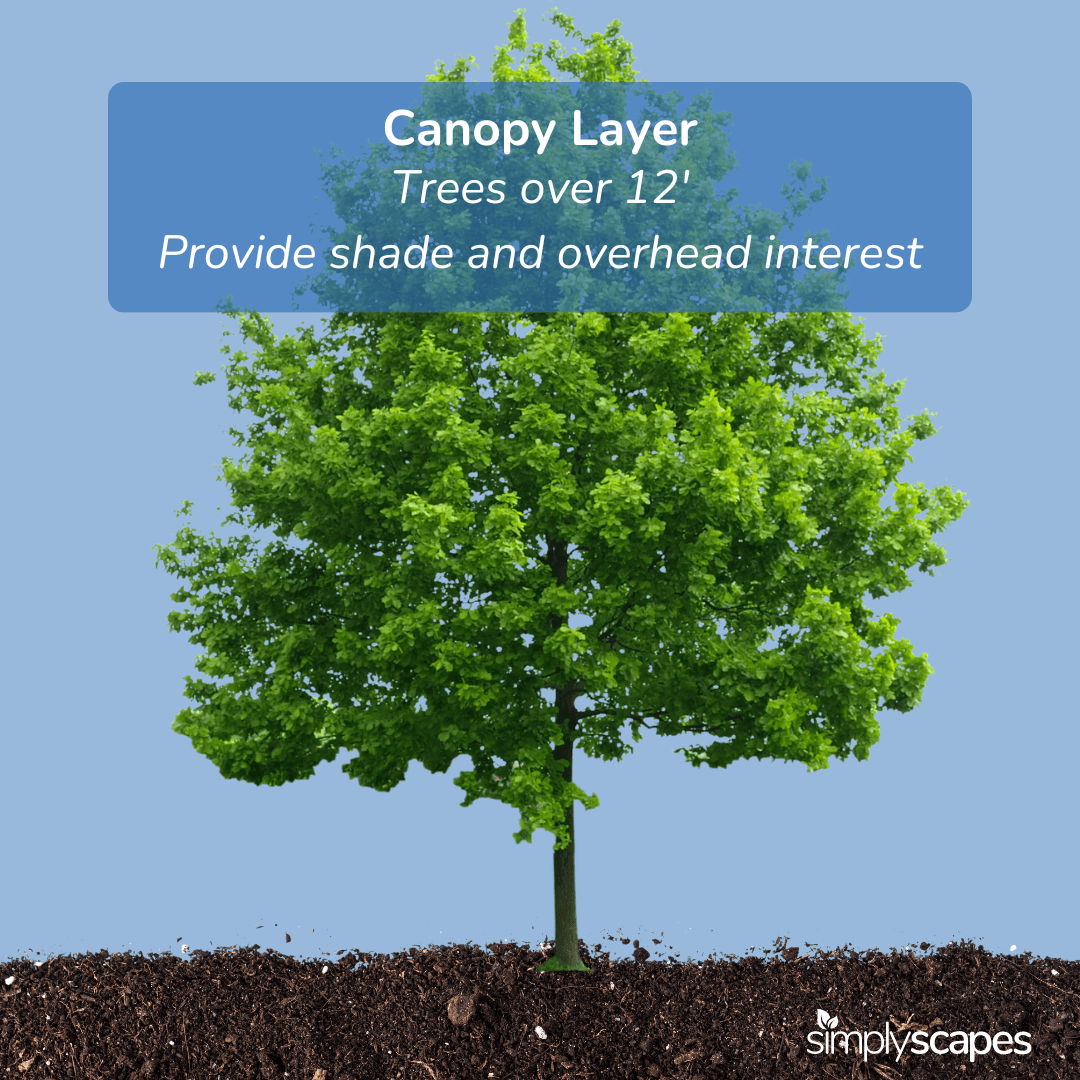
Privacy
Privacy plants are the next size down—small or columnar trees and taller shrubs and grasses. These are often found on the edge of the yard and stay around 6-12 feet tall. These plants serve to provide screening—blocking views you don’t want, add privacy, and bring interest.
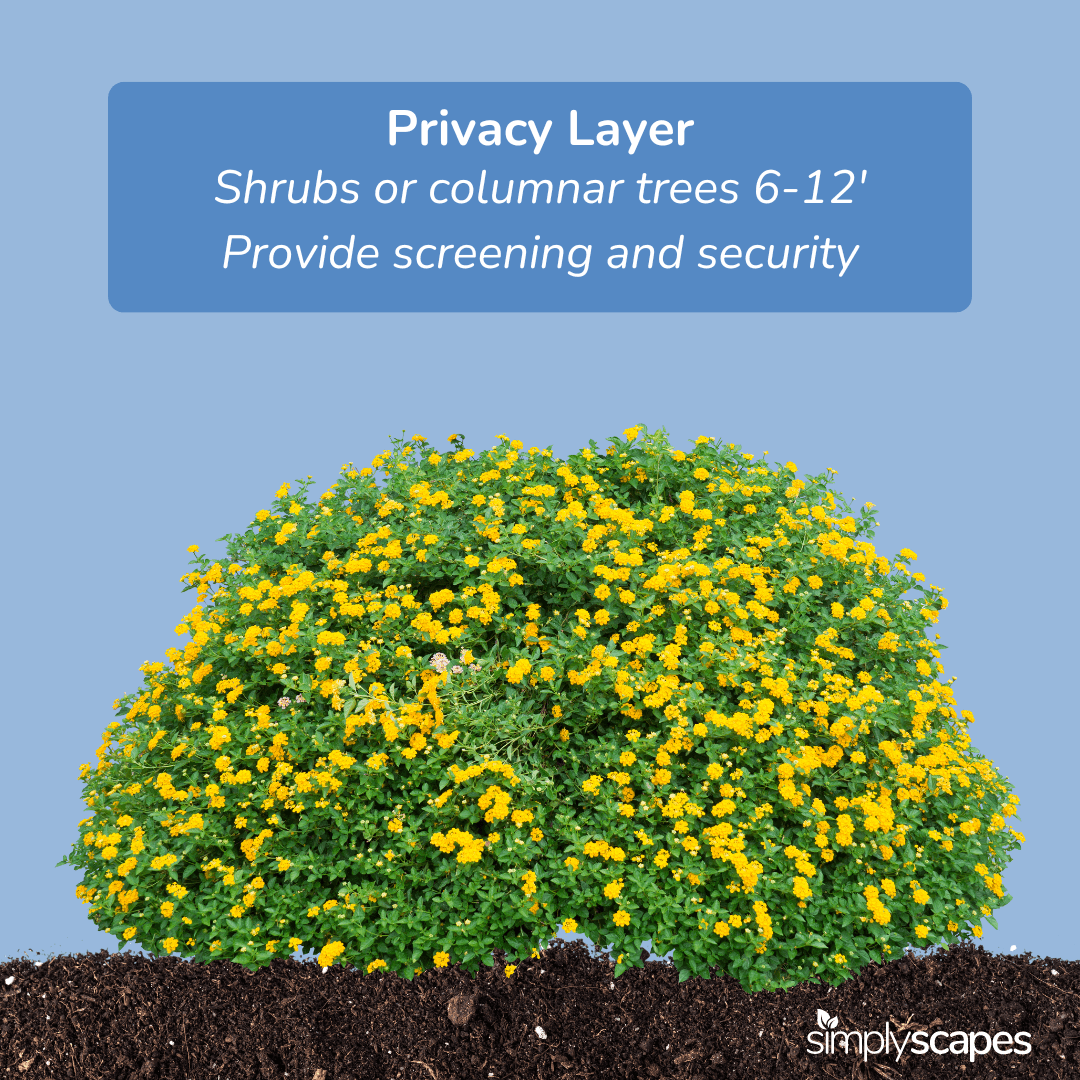
Transition
Transition plants are mid-sized shrubs, ornamental grasses, tall perennials, and cacti or larger succulents. These plants stay around 3-6 feet tall/wide, and you’ll use a lot of these in your landscape.
They’re large enough to create separation but not total privacy. Transition plants are great to put against the foundation of the house or in front of the perimeter shrubs in your design.
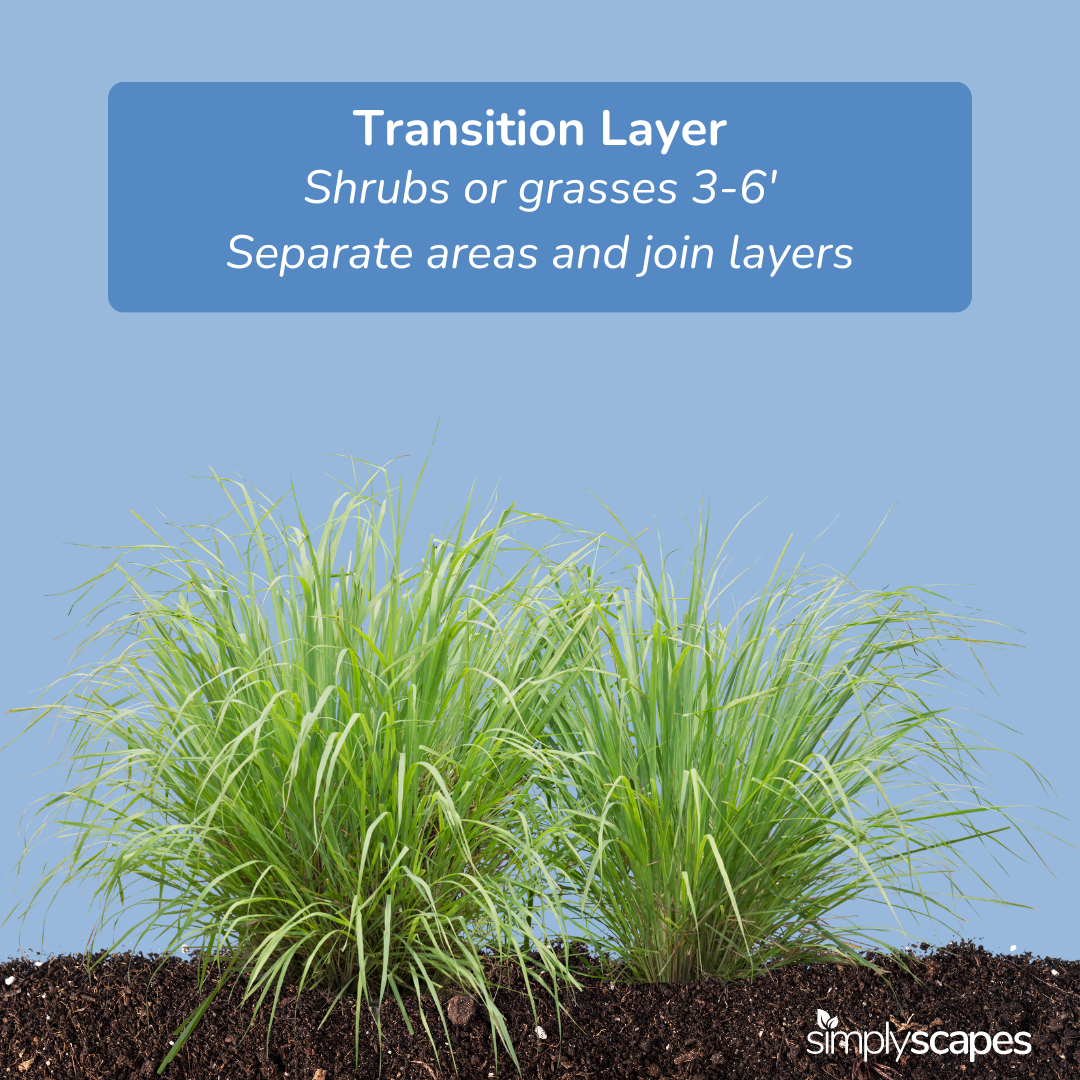
Detail
Detail plants are smaller perennials, grasses and ground covers in the range of 1-3 feet tall. It’s a good idea to choose detail-size perennials with show-stopping blooms. Just remember to space them out through your yard so you have blooms throughout the space all season long. These fill in the front edge of your planter beds and cover the ankles (or bases) of the shrubs behind them. If you include enough of this plant to fill in your planters along with a drip irrigation system, you’ll be able to avoid unwanted weeding and decrease your maintenance.

Surface
Surface plants sprawl pleasantly around the base of your other plants and act as living mulch, minimizing weed growth, retaining moisture in the soil, and moderating soil temperatures. Because they only grow up to a foot high, you’ll want to ensure that they are placed at the front of your planters.
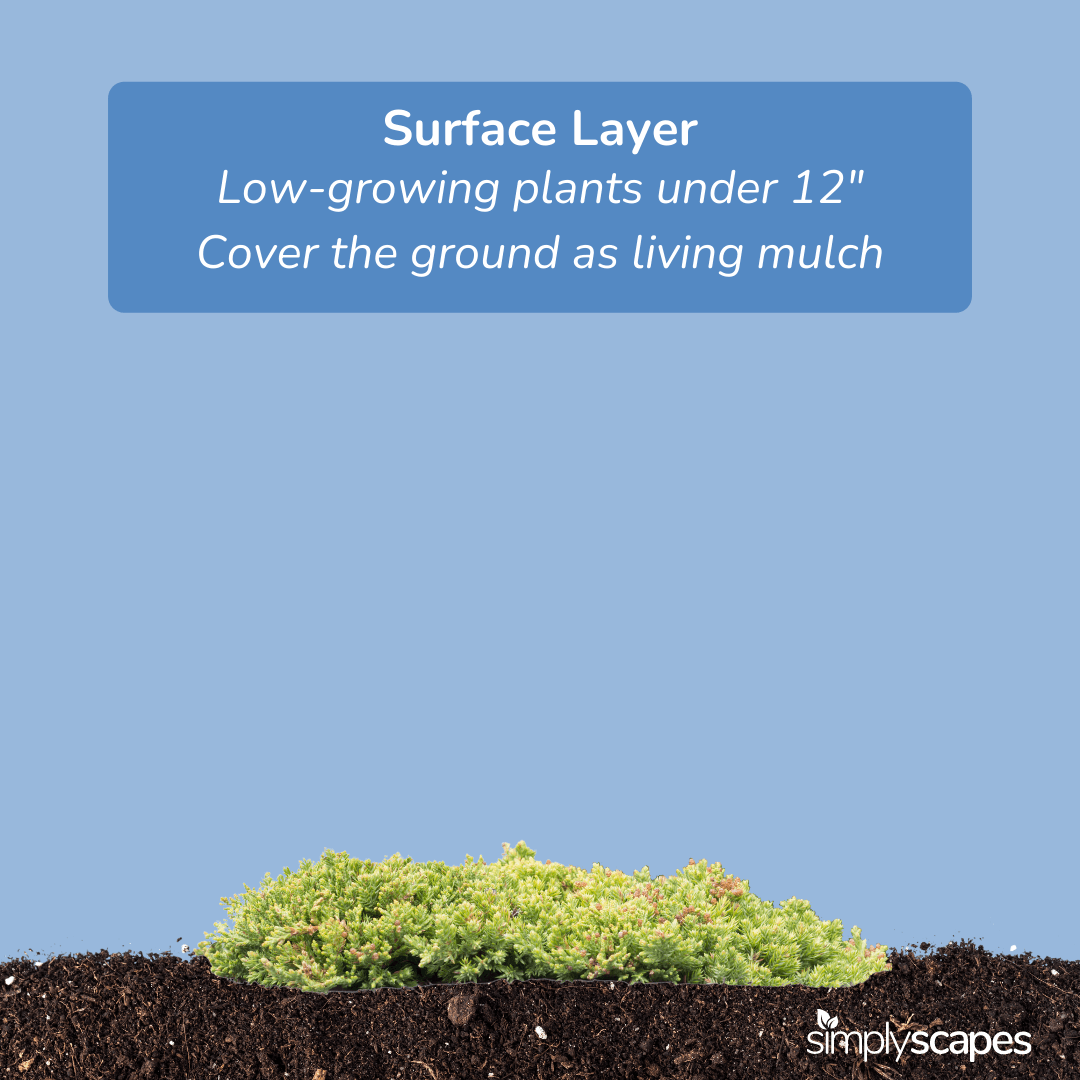
Containers
In a well designed yard, you won’t need to rely on annuals for beauty and interest each year. Even though it may be more of an investment upfront, using primarily perennials in your yard will save you time, money, energy, and water in the future. However, we love petunias, geraniums, and marigolds just as much as you do. In order to maximize their effect while minimizing all of the negatives we just mentioned, we recommend planting your annuals in containers. This helps them to really pop and makes the process of planting and pulling each season so much easier!
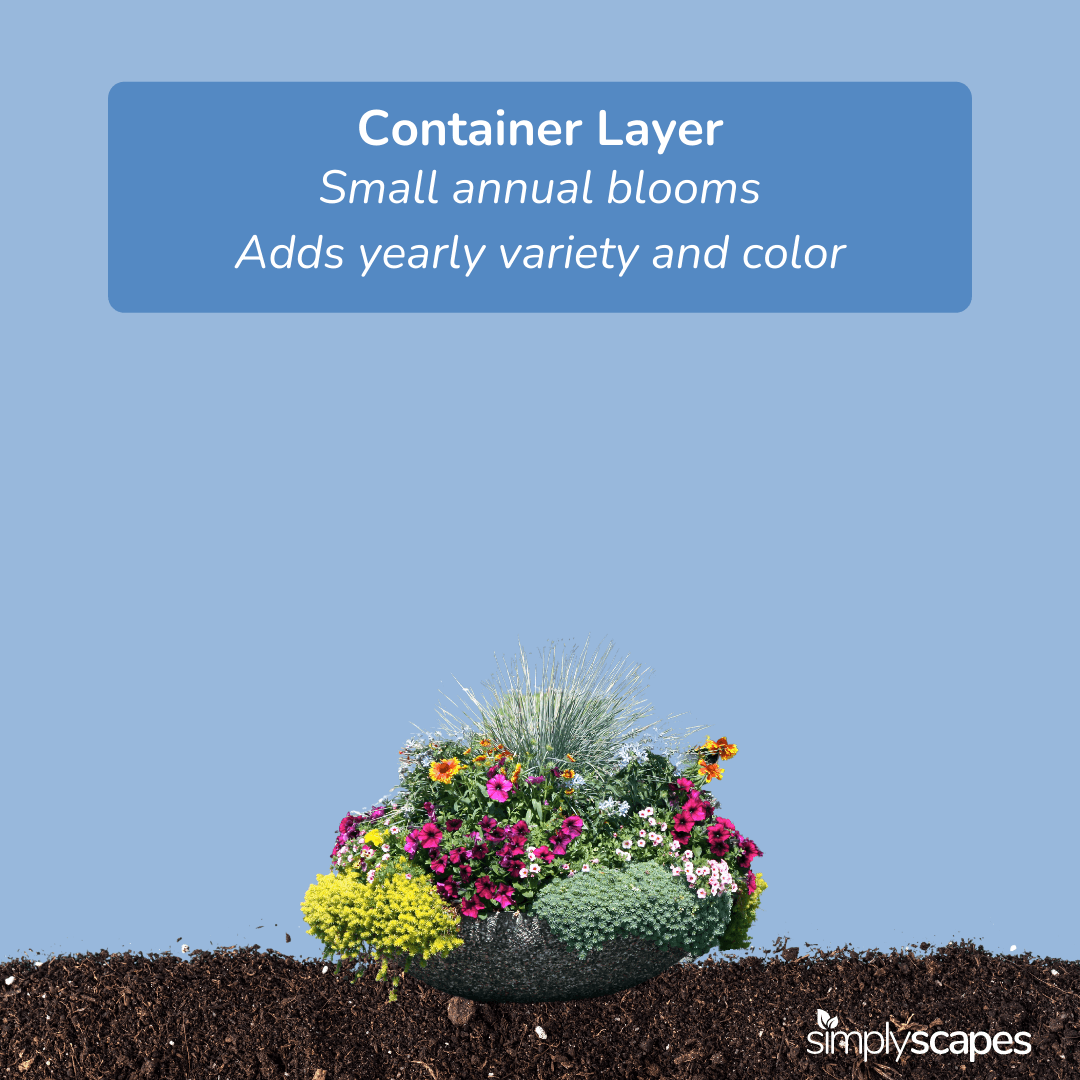
Plant Features
As you’re filling out the vertical layers of your plant roster, it’s helpful to know what to look for. With an overwhelming amount of plant options, there are three main characteristics that will help you select plants for each layer: bloom, texture, and foliage. Incorporating a good mix of these features will bring contrast and harmony to your design.
Bloom
Blooms come in many colors, shapes, and sizes, and they often take the spotlight in a landscape. When choosing your blooms, you should consider the season in which they bloom and for how long. Using the Simplyscapes app, you can easily do this using the “Seasonal Sizzle” feature.
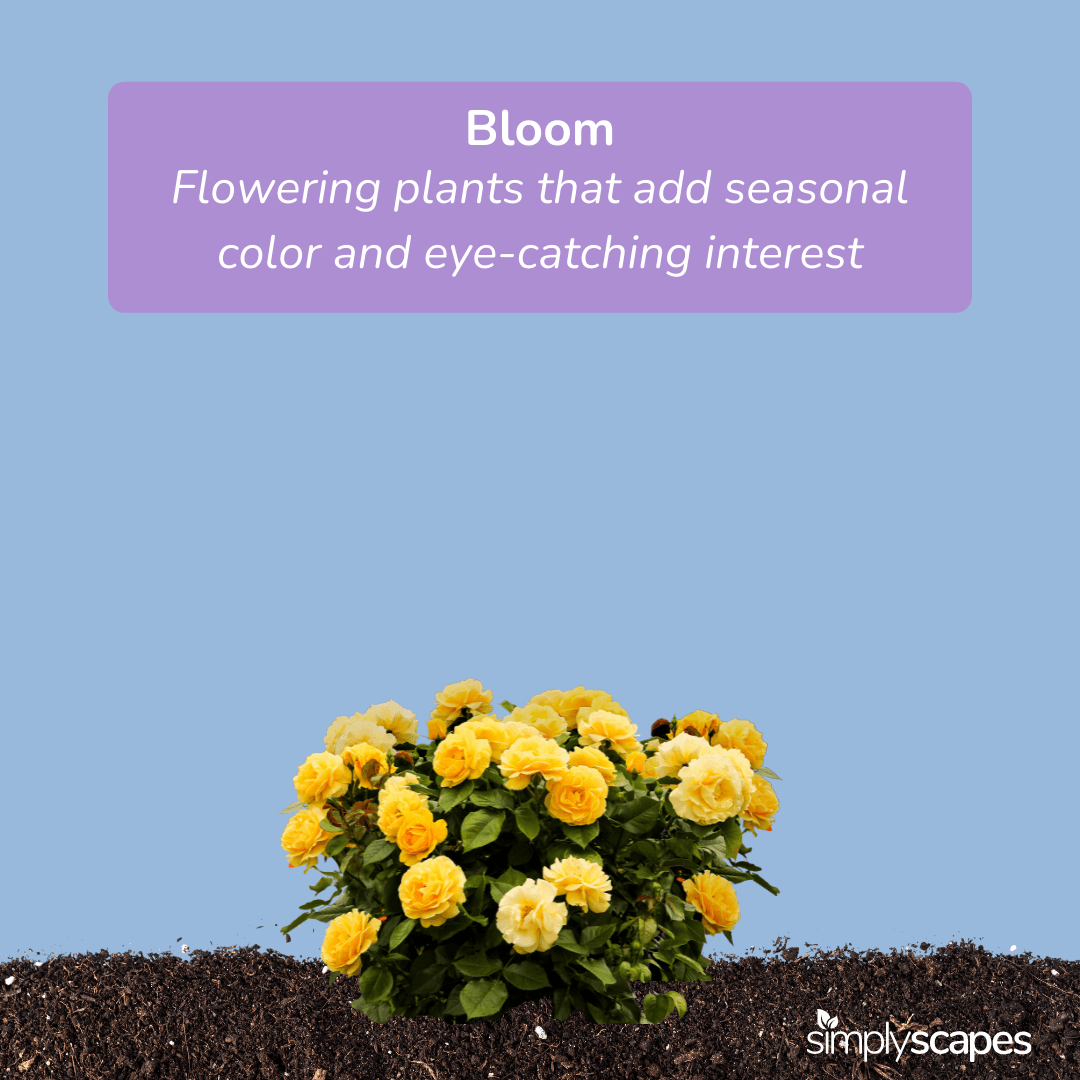
Foliage
Foliage plants are chosen based on their leaf color. Some of your foliage plants, like the Japanese Maple pictured above, may keep their color all season. However, you may choose some plants that have exceptional spring (forsythia) or fall (chokeberry) color. The color of these plants add more consistent interest to your landscape, helps to break up the greenery, and makes your blooms really pop!
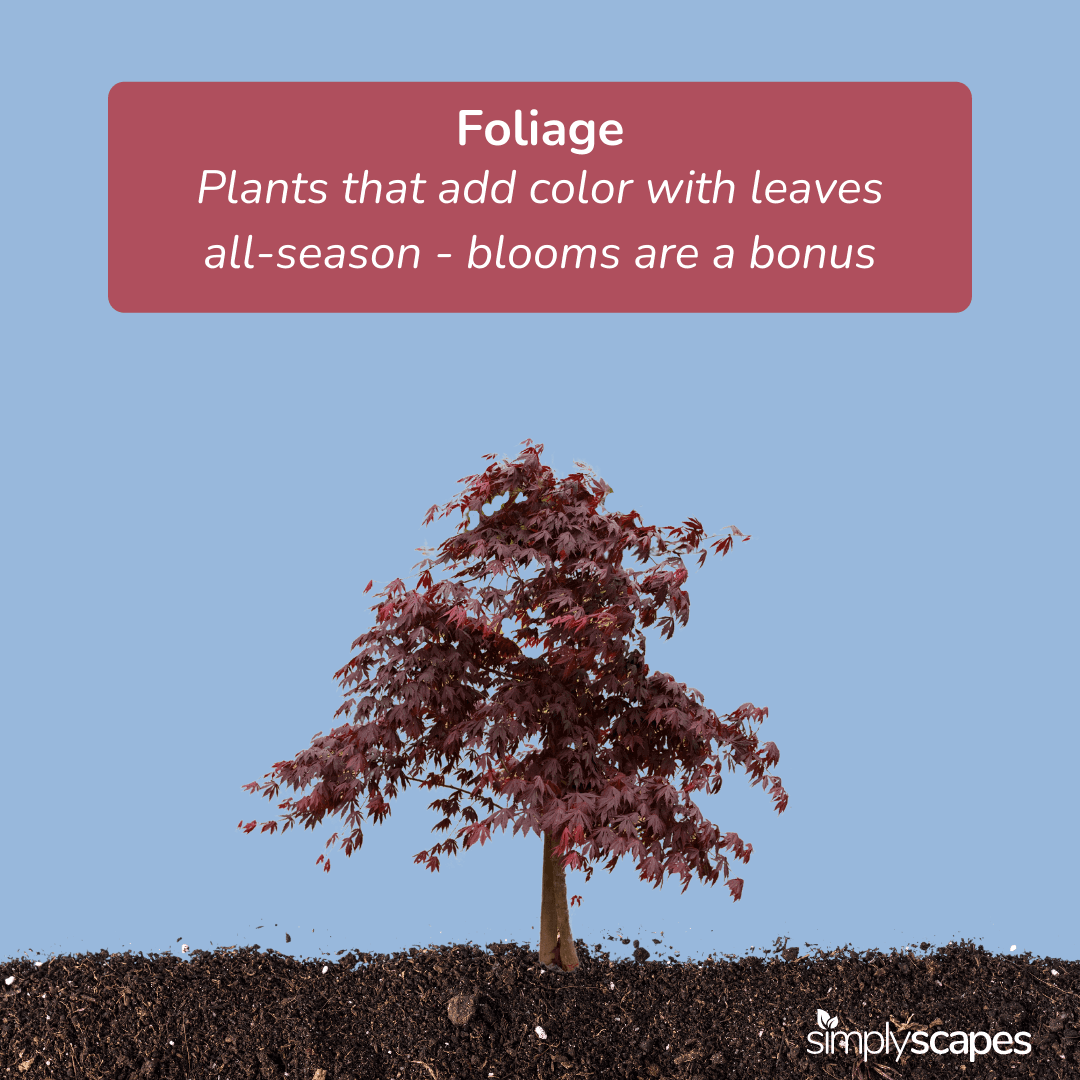
Texture
For your texture plants, look for leaves with an interesting shape or surface. These plants add more visual diversity and compliment blooms and foliage. Some examples of different textures include fine needles, furry leaves, or sprouting grasses.

Remember
Each plant in your yard can be categorized vertically, and there are three main features that will help you fill out the categories. As you can see in the picture above, a beautiful landscape is composed of cohesive and contrasting plants that make much more of an impact together than they do individually. If you start to feel lost while making your plant selections, just take a step back and think about what you want each plant to do and don’t worry so much about making each choice “perfect.” When it comes to plants, there’s no one size fits all answer, but incorporating these principles will bring you as close to perfect as you can get!
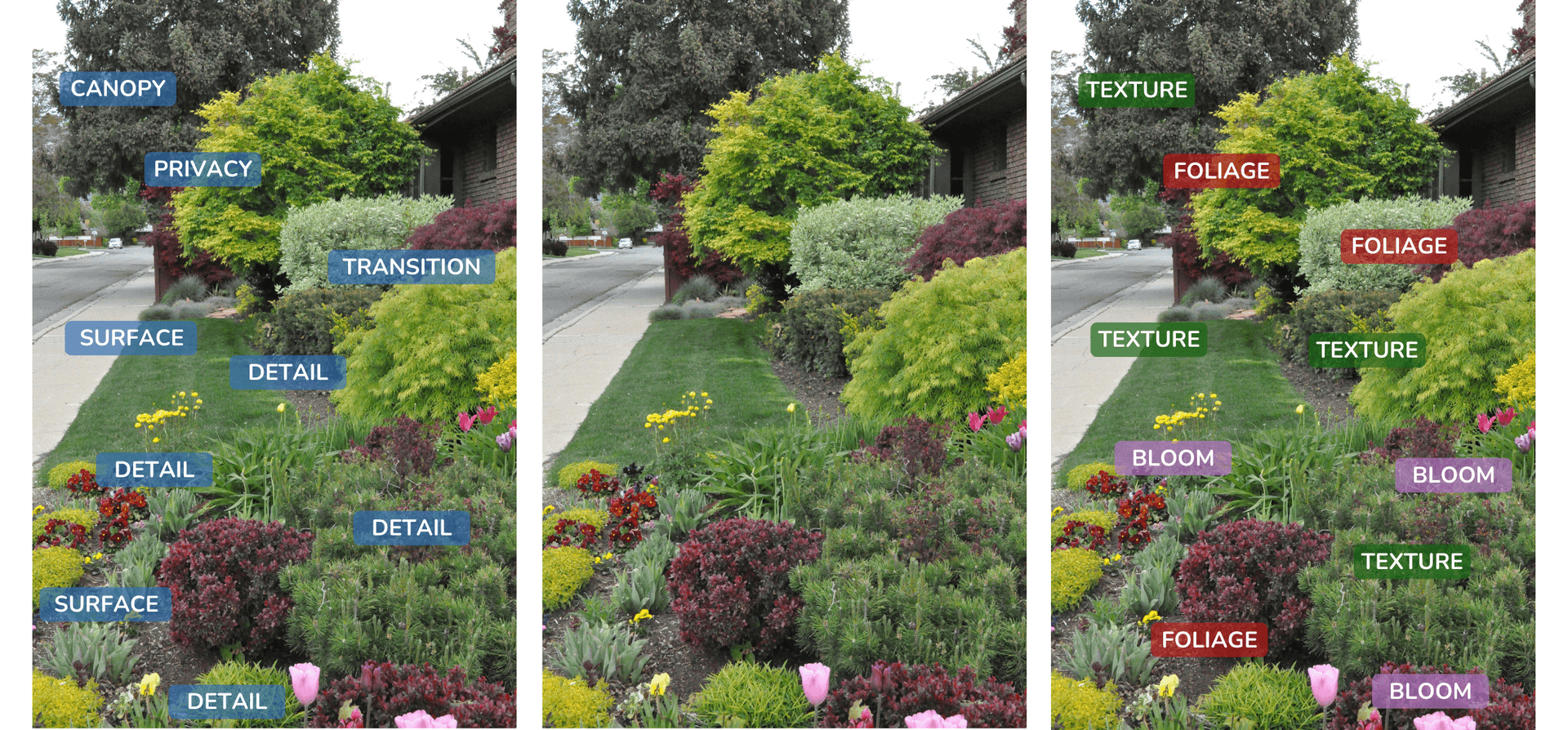
Honing in on Plant Selection
Now that you have the vertical layers in mind and you know to incorporate a balance of bloom, texture, and foliage color. For the last step of this fail-safe formula, it’s time to hone in on plant selection.
There are a few subsections to help you in this process; we’ve already touched on all of these desired qualities and they’re all found in our app, as well. This section of the formula will break down the general amount and placement of the plants you’ve figured into your plan.
First, an ALL-SEASON ANCHOR. These are perennials with a long blooming period, nice foliage, and/or a fun texture and will be repeated at least three times throughout your landscape, preferably five or more times. Anchor plants should make up about twenty percent of the plants in your plan.
Next, a SEASONAL SIZZLE. As the name suggests, these plants have their shining moment for a season. Planning for plants that bring the “wow” factor during staggering seasons will have your yard constantly bringing new and exciting views.
Another category, FOLIAGE FOCUS, brings interest without relying on blooms (blooms are just a bonus in this group). These can be picked for shape, texture, and color. Though they work in every layer, foliage plants are often most impactful in the privacy or transition layers. In the case of larger plants, one might be enough to fill a space. Smaller plants can be arranged in groupings of three to five.
Finally, the WILDCARDS. This category is made up of plants you see in the nursery that you fall in love with on the spot, plants that were gifted to you, those that are already existing in your landscape, memory plants for friends or family, short-lived pops of color, and plants you just plain like.
All together, these plant combinations will help to complete a “full-roster” of plants that can be swapped in and out of your yard to make a truly stunning landscape, without relying on a single plant to get the job done.
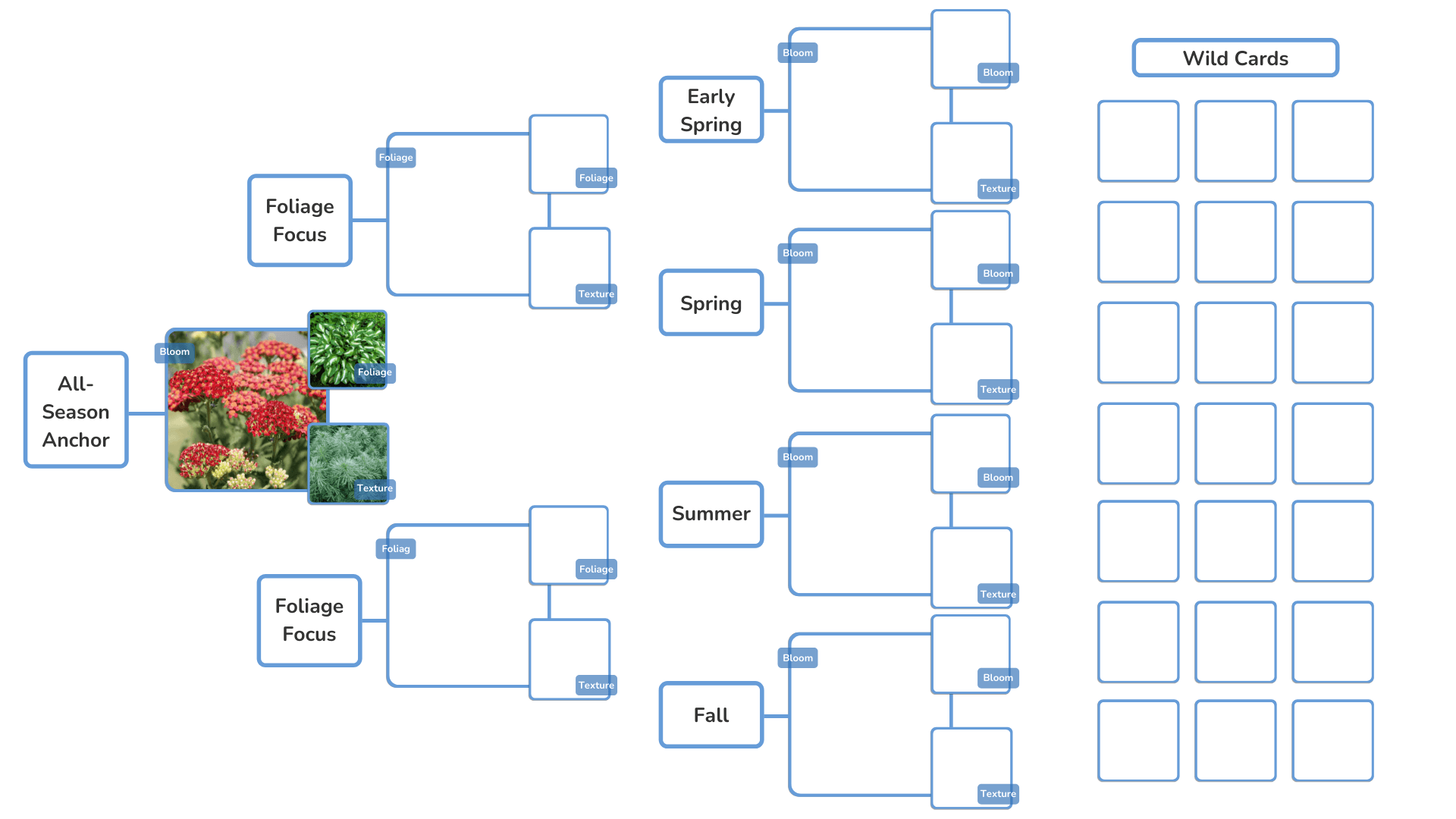
Shaping Up
When deciding where to put all of these plant combos, it’s generally a good idea to visualize a triangular spacing across your yard. You’re going to repeat plants in many of the layers, so you’ll want them spread out in your landscape in a way that feels balanced and flows well. Repeating them three times, pretty evenly spaced out around your yard, is an easy way to ensure balance.
With this method, the visual weight is evenly distributed, the spaced-out repetition creates rhythm and movement, and you’ll almost always have plants blooming no matter which direction you look.
Applying the Formula
Now that we’ve given you the formula, it’s a simple process for you to have the landscape of your dreams. As you work in plants from each layer, being mindful of the characteristics and qualities they bring to the table, you’ll have a balanced, cohesive landscape full of delightful color, texture, and contrast throughout the seasons!
Be sure to use a premium design to speed through the design process and visualize it every step of the way!

